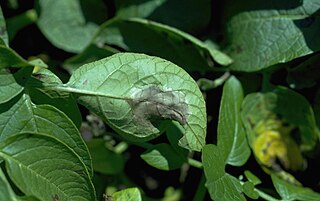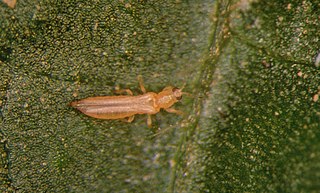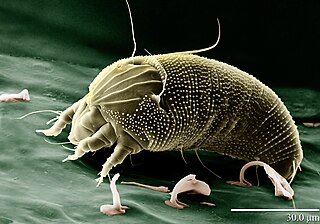In biology, a kingdom is the second highest taxonomic rank, just below domain. Kingdoms are divided into smaller groups called phyla.

Phytophthora infestans is an oomycete or water mold, a fungus-like microorganism that causes the serious potato and tomato disease known as late blight or potato blight. Early blight, caused by Alternaria solani, is also often called "potato blight". Late blight was a major culprit in the 1840s European, the 1845–1852 Irish, and the 1846 Highland potato famines. The organism can also infect some other members of the Solanaceae. The pathogen is favored by moist, cool environments: sporulation is optimal at 12–18 °C (54–64 °F) in water-saturated or nearly saturated environments, and zoospore production is favored at temperatures below 15 °C (59 °F). Lesion growth rates are typically optimal at a slightly warmer temperature range of 20 to 24 °C.

Mites are small arachnids. Mites span two large orders of arachnids, the Acariformes and the Parasitiformes, which were historically grouped together in the subclass Acari. However, most recent genetic analyses do not recover the two as each other's closest relative within Arachnida, rendering the group non-monophyletic. Most mites are tiny, less than 1 mm (0.04 in) in length, and have a simple, unsegmented body plan. The small size of most species makes them easily overlooked; some species live in water, many live in soil as decomposers, others live on plants, sometimes creating galls, while others are predators or parasites. This last type includes the commercially destructive Varroa parasite of honey bees, as well as scabies mites of humans. Most species are harmless to humans, but a few are associated with allergies or may transmit diseases.

Tetranychus urticae is a species of plant-feeding mite generally considered to be a pest. It is the most widely known member of the family Tetranychidae or spider mites. Its genome was fully sequenced in 2011, and was the first genome sequence from any chelicerate.

Pseudomonas putida is a Gram-negative, rod-shaped, saprophytic soil bacterium. It has a versatile metabolism and is amenable to genetic manipulation, making it a common organism used in research, bioremediation, and synthesis of chemicals and other compounds.

Tomato bushy stunt virus (TBSV) is a virus of the tombusvirus family. It was first reported in tomatoes in 1935 and primarily affects vegetable crops, though it is not generally considered an economically significant plant pathogen. Depending upon the host, TBSV causes stunting of growth, leaf mottling, and deformed or absent fruit. The virus is likely to be soil-borne in the natural setting, but can also be transmitted mechanically, for example through contaminated cutting tools. TBSV has been used as a model system in virology research on the life cycle of plant viruses, particularly in experimental infections of the model host plant Nicotiana benthamiana.

The British Mycological Society is a learned society established in 1896 to promote the study of fungi.

The tomato is the edible berry of the plant Solanum lycopersicum, commonly known as the tomato plant. The species originated in western South America, Mexico, and Central America. The Nahuatl word tomatl gave rise to the Spanish word tomate, from which the English word tomato derived. Its domestication and use as a cultivated food may have originated with the indigenous peoples of Mexico. The Aztecs used tomatoes in their cooking at the time of the Spanish conquest of the Aztec Empire, and after the Spanish encountered the tomato for the first time after their contact with the Aztecs, they brought the plant to Europe, in a widespread transfer of plants known as the Columbian exchange. From there, the tomato was introduced to other parts of the European-colonized world during the 16th century.

Alternaria alternata is a fungus causing leaf spots, rots, and blights on many plant parts, and other diseases. It is an opportunistic pathogen on over 380 host species of plant.

Pyrenochaeta lycopersici is a fungal plant pathogen, infecting tomatoes and causing corky root rot.

Tydeidae is a family of acariform mites. As of 2016, it contained over 300 species in three subfamilies, though more species have been discovered since then.

The western flower thrips [Frankliniella occidentalis (Pergande)] is an invasive pest insect in agriculture. This species of thrips is native to the Southwestern United States but has spread to other continents, including Europe, Australia, and South America via transport of infested plant material.

Aceria is a genus of mites belonging to the family Eriophyidae, the gall mites. These tiny animals are parasites of plants. Several species can cause blistering and galls, including erineum galls. A few are economically significant pests, while others are useful as agents of biological pest control of invasive plants such as rush skeletonweed, creeping thistle, and field bindweed.

A genetically modified tomato, or transgenic tomato, is a tomato that has had its genes modified, using genetic engineering. The first trial genetically modified food was a tomato engineered to have a longer shelf life, which was on the market briefly beginning on May 21, 1994. The first direct consumption tomato was approved in Japan in 2021. Primary work is focused on developing tomatoes with new traits like increased resistance to pests or environmental stresses. Other projects aim to enrich tomatoes with substances that may offer health benefits or be more nutritious. As well as aiming to produce novel crops, scientists produce genetically modified tomatoes to understand the function of genes naturally present in tomatoes.
Miniature Inverted-repeat Transposable Elements (MITEs) are a group of non-autonomous Class II transposable elements. Being non-autonomous, MITEs cannot code for their own transposase. They exist within the genomes of animals, plants, fungi, bacteria and even viruses. MITEs are generally short elements with terminal inverted repeats and two flanking target site duplications (TSDs). Like other transposons, MITEs are inserted predominantly in gene-rich regions and this can be a reason that they affect gene expression and play important roles in accelerating eukaryotic evolution. Their high copy number in spite of small sizes has been a topic of interest.
High Plains wheat mosaic emaravirus (WMoV), or High Plains virus (HPV) or Maize red stripe virus (MRSV/MRStV) is the causative agent of High plains disease of maize and wheat. It is spread by wheat curl mite, Aceria tosichella, which also transmits Wheat streak mosaic virus. The mite's ability to transmit a number of different viruses to cereal crops make it an economically important agricultural pest. In late June 2017 this virus was first detected in Canada, in Alberta. The Alberta samples were 99% similar to those in the USA. As Wheat streak mosaic virus is already present in Alberta, and coinfection with these two causes even more severe damage, this could cause much higher yield losses.

Aculops fuchsiae, commonly known as fuchsia gall mite, is a species of mite in the family Eriophyidae. It feeds on Fuchsia plants, causing distortion of growing shoots and flowers. It is regarded as a horticultural pest.

Aculops is a genus of mites that belongs to the family Eriophyidae that live as plant parasites. Some species, such as Aculops lycopersici, are severe crop or ornamental pests, while Aculops ailanthii is being considered as biocontrol for the extremely invasive tree-of-heaven in North America. Very little is known about this genus, with new species constantly being discovered even in well covered regions such as New Zealand.
Parapedobacter lycopersici is a Gram-negative, aerobic and rod-shaped bacterium from the genus of Parapedobacter which has been isolated from the rhizospheric soil from a tomato plant from a greenhouse from Yecheon-gun in Korea.



















